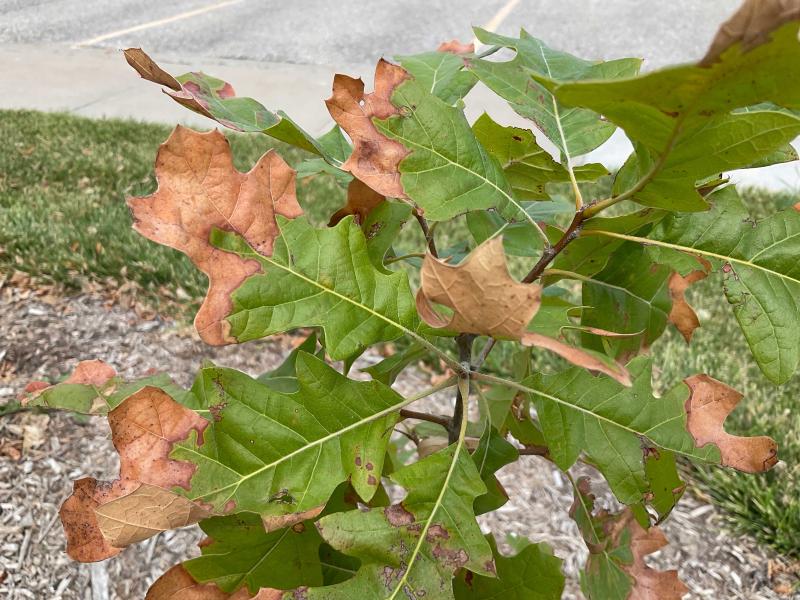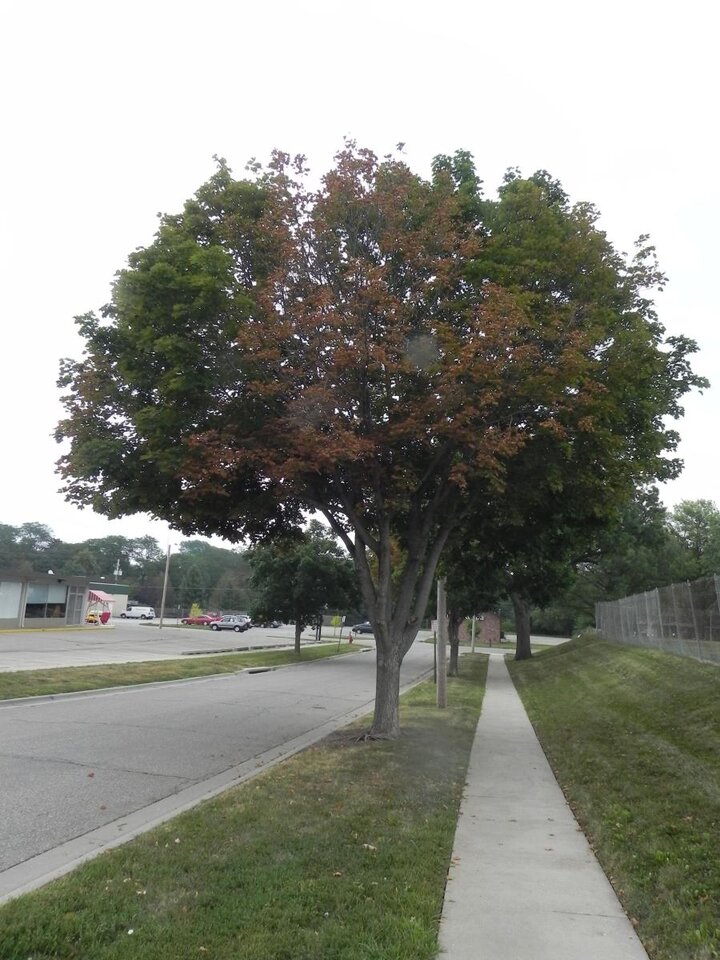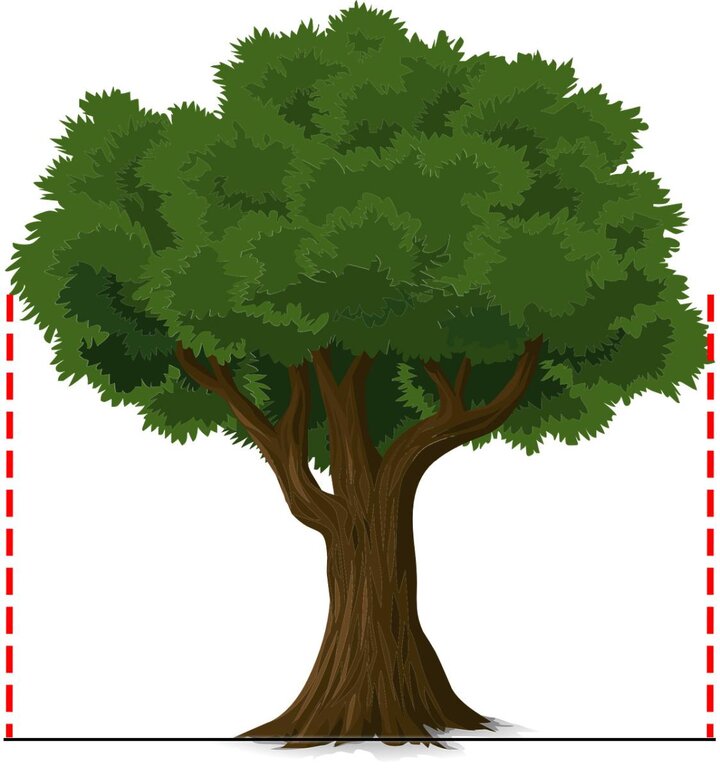Sarah Browning, Nebraska Extension Educator

Leaf scorch on a newly-planted black oak. Image by Sarah Browning, Nebraska Extension
High temperatures and dry conditions have resulted in many lawns turning brown in the last few weeks, but all plants suffer during hot, dry conditions not just lawns. From June 1 to July 24, 2022, we’ve had 24 days of 90+ degree heat this summer. Lancaster County had a rain deficit of 0.75 inches in June and we’re also 0.84 inches short for July, based on normal monthly rainfall averages from the High Plains Regional Climate Center (CLIMOD). For a current look at Lincoln drought status, visit U.S. Drought Monitor.
With all the heat and dry conditions, landscape plants would benefit from watering to keep them healthy.
Drought stress is often slower to appear in woody plants than it is in lawns, but can have long-term consequences. Extremely dry conditions result in root death, which take time to regrow. Drought stressed trees are more susceptible to secondary attack by insect pests and disease problems, such as borers and canker diseases, which can kill the tree.
Knowing how and when to water, as well as setting landscape priorities can help you focus your efforts. Considering a plant’s beneficial contributions to your landscape and the difficulty, length of time and cost needed to reestablish if it should die, landscape priorities are usually ranked as follows.
- Trees
- Shrubs
- Perennial and ornamental plants
- Turfgrass
Plants should receive one inch of water per week, either through rain or irrigation. Monitor rainfall and make a note when your landscape doesn't receive 1-inch per week.
But how can you tell when the soil is dry enough to need watering? Use a long-bladed screwdriver to check the depth of water penetration and amount of soil moisture. Test soil you know is moist and note the resistance when you push it into the ground to a depth of 8 to 12-inches. Then try an area of dry soil to feel the difference; it should be much harder! Once you get a feel for the typical resistance of your soil under dry conditions, use it to determine when the soil is drying out and needs water.

Drought Stress Symptoms
One common symptom of drought stress is leaf scorching, a uniform yellowing or browning of the edges of leaves on broadleaf plants or the tips of evergreen needles. But sometimes leaf scorch can be blotchy in appearance and scattered throughout the leaves, not an even browning around the edges. Under very dry conditions, leaf scorch will advance to yellow/brown leaves falling from the tree, wilting, branch and twig death, or plant death.
However, even trees that don't exhibit leaf scorch can be experiencing drought stress.
Young or newly planted trees and shrubs are most susceptible to drought injury, because they have not yet established the extensive root system needed to draw moisture from the soil during dry conditions. Woody plants should be considered “newly planted” for 5-10 years after planting.
How Deep are Tree Roots?
To water properly, it’s important to know where, how much and how often water should be applied to landscape trees. Water should always be placed where the roots are growing. Research shows a majority of water-absorbing tree roots are in the top 24 inches of soil, where the water, oxygen and nutrients they need for healthy growth are available.
One mistake frequently made by homeowners with in-ground irrigation systems, is watering too often. Applying a light application of water daily or every other day results in a shallow layer of continually saturated soil. It also drives oxygen out of the underlying soil, resulting in severe root decline or death. Frequent, light applications of water is one of the most common causes of tree death.
Water requirements for trees vary by species, size of tree and soil type. Of these, soil type is the greatest factor in watering frequency and amount. Sandy soils absorb water quickly and release it easily to plants, but the amount of water sandy soil can hold is low. Clay soils hold a lot of water, but absorb it slowly.
Sandy Soil
It is almost impossible to overwater trees in sandy soil, though it is wasteful. When too much water is applied to sandy soil it drains quickly through the soil and isn't available to tree roots. Ideally, soil should be moist 18 inches deep for as long as the tree is growing. Watering every five to seven days may be necessary for trees in sandy soils to maintain adequate moisture when conditions are hot and windy.
Clay Soil
Proper watering can be difficult in clay soils because water penetrates its' small pores spaces slowly. Water applied too quickly runs off and is wasted. However, once clay soils are wet they hold moisture for long periods of time. Deep, infrequent applications of water are recommended for clay soils.

To avoid water runoff, apply water slowly. When using an irrigation system, try the soak and cycle method. Cycle through your zones once using a run time short enough to stop irrigation before water starts to run off the landscape, then cycle through the zones a second time in the same day to achieve a deeper level of watering.
If using a hose and sprinkler, let it run in a low pattern in one area until the top 8-12 inches of soil is moistened then move it as needed to water the entire area underneath the tree's canopy. A deep soaking every 2 weeks is adequate for most trees in unirrigated landscapes.
Focus on watering the entire area beneath the tree’s dripline – the area from the trunk to the outer edge of the widest branches. For columnar trees, water the entire area from the trunk to a distance at least one-half the tree's height away from the trunk.
Finally, make sure trees and shrubs have a flat 3 to 4-inch layer of wood chip mulch around their base to hold in soil moisture and keep mowers or string trimmers away from their trunk.
Images
- Leaf scorch in an established maple tree.
- Focus on watering the entire area beneath the tree’s dripline – the area from the trunk to the outer edge of the widest branches. Image from Pixabay.com.